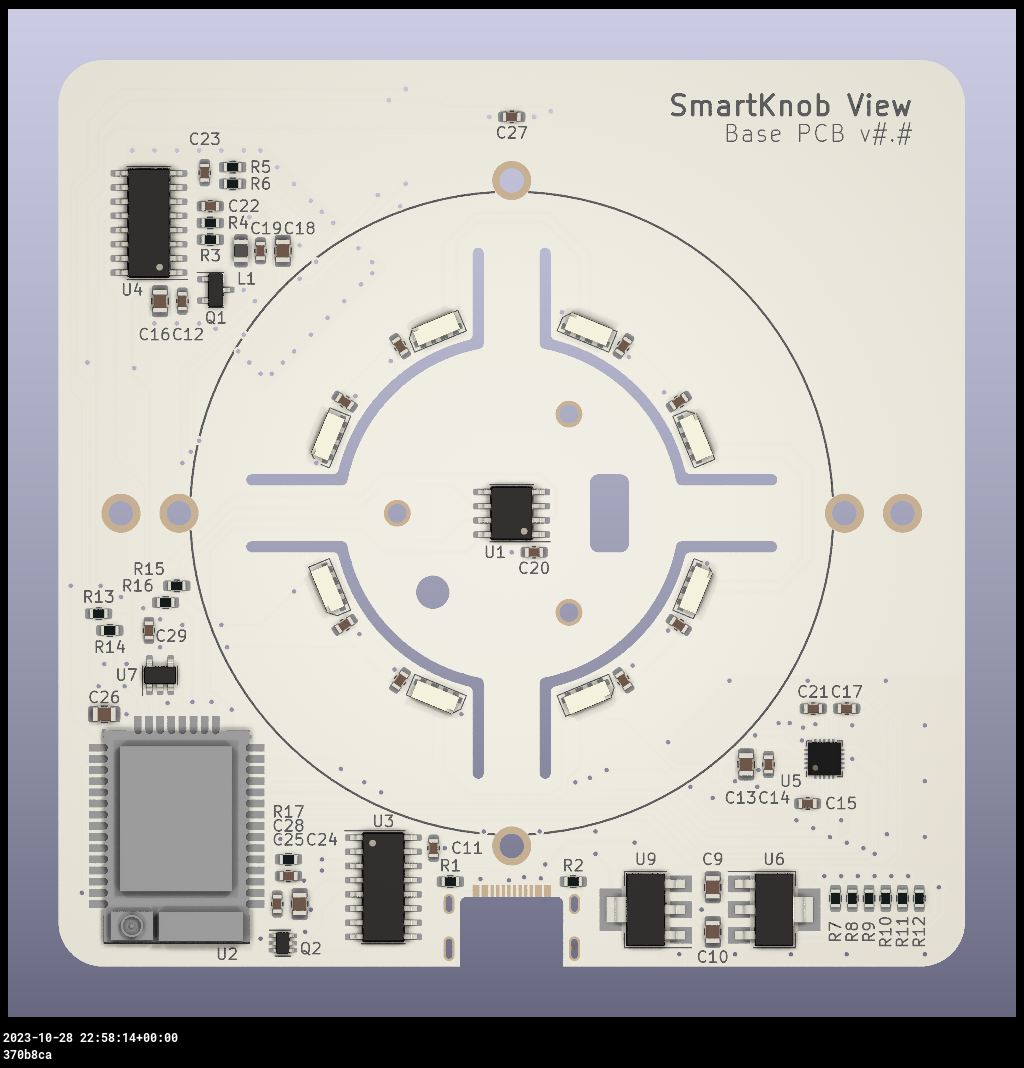scottbez1 / smartknob
- вторник, 15 марта 2022 г. в 00:31:48
Haptic input knob with software-defined endstops and virtual detents
SmartKnob is an open-source input device with software-configurable endstops and virtual detents.
A brushless gimbal motor is paired with a magnetic encoder to provide closed-loop torque feedback control, making it possible to dynamically create and adjust the feel of detents and endstops.
Premium SmartKnob experience. Under active development.
Not recommended for general use yet (mechanical and electrical revisions are planned).
Requires advanced soldering experience to build - reflow and/or small-pitch surface-mount soldering are required, and assembly is quite time-consuming and delicate.
Features:

Latest Fusion 360 Model: https://a360.co/3BzkU0n
More documentation on the BOM and what parts you need to order is coming in the future - thanks so much for your interest! Follow me on Twitter for the latest updates on this and other projects.
View the Base PCB Interactive BOM and Screen PCB Interactive BOM (or, the combined BOM csv) for electronics/hardware parts list.
A few miscellaneous notes in the meantime:
Future plans:


Ordering notes: use white soldermask, for reflecting light from RGB LED ring around the knob. Should be 1.2mm thick (not "standard" 1.6mm).


Ordering notes: Must be 1.2mm thick (not "standard" 1.6mm) per mechanical design.
An exploration of a small handheld form-factor. Under active development.
Planned for the future.
Excellent sensor at a reasonable price - highly recommended. Less noisy than TLV493D, and more responsive (control loop is more stable) using SSI.
A mediocre choice. Easy to prototype with using Adafruit's QWIIC breakout board.
In my testing, it is a little noisy, requiring filtering/smoothing that can slow responsiveness, hurting control loop stability. Or, with less filtering, the noise can easily be "amplified" by the derivative component in the PID motor torque controller, causing audible (and tactile) humming/buzzing.
There is also apparently a known silicon issue that causes the internal ADC to sometimes completely lock up, requiring a full reset and re-configuration. See section 5.6 in the User Manual
In the Master Controlled Mode (MCM) or the Fast Mode (FM) the ADC conversion may hang up. A hang up can
be detected by:
- Frame Counter (FRM) counter stucks and does not increment anymore.
In my experience testing 4 different Adafruit breakout boards, 2 of them (50%) regularly exhibit this lockup behavior within a minute or two of use. It is possible to detect and auto-reset (and there is code in the project to do so), but it is slow and may cause undesirable jumps/delays if the sensor locks up often.
A mediocre choice. Cheap breakout boards are readily available.
In my testing, it's fairly noisy (anecdotally, noisier than the TLV493d), requiring filtering/smoothing that can slow responsiveness, hurting control loop stability. Additionally, it saturates at a lower magnetic field strength than other sensors I tested, requiring a significant air gap (8-10mm) when used with a strong neodymium diametric magnet like Radial Magnets 8995.
This is a relatively new IC and it's a perfect match! There generally aren't any other drivers (with integrated fets) that meet the requirements for the low-voltage and low-current motors used in this project (DRV8316 might work, but has not been tested).
Highlights:
This is overall the easiest motor to get started with. Low cogging and a built-in diametric magnet are great!
Coming soon: I've ordered over a dozen different BLDC motors to test and will create an overview of which ones are suitable for this kind of haptic feedback use-case.
TODO: document this
Also TODO: implement a lot more of the firmware
How much does it cost?
I wish I could tell you now, but I don't actually know off the top of my head. Check back soon - I've only built 1 so far, which was the result of a bunch of tinkering and prototyping over an extended period, so I don't have all the expenses tallied up yet. Certainly less than $200 in parts, and maybe closer to $100?
Does it work with XYZ?
Not yet. So far I've only implemented enough firmware for the demo shown in the video, so you can't actually use it for anything productive yet. The basic detent configuration API is there, but not much else. Lots of firmware work remains to be done. If you build one, I'd love your help adding support for XYZ though!
Can I buy one as a kit or already assembled?
Probably not? Or at least, I don't have any immediate plans to sell them myself. It's not that I don't want you to be happy, but hardware is a hard business and I just work on this stuff in my free time.
It's open source with a fairly permissive license though, so in theory anyone could start offering kits/assemblies. If someone does go down that route of selling them, note that attribution is
required (and I wouldn't say no to royalties/tips/thanks if you're in a giving mood
This project was greatly inspired by Jesse Schoch's video "haptic textures and virtual detents" and the corresponding discussion in the SimpleFOC community. Seriously, this project wouldn't exist if not for that video - thank you Jesse!
This project is licensed under Apache v2 (software, electronics, documentation) and Creative Commons Attribution 4.0 (hardware/mechanical) (see LICENSE.txt and Creative Commons).
Copyright 2022 Scott Bezek
Licensed under the Apache License, Version 2.0 (the "License");
you may not use this file except in compliance with the License.
You may obtain a copy of the License at
http://www.apache.org/licenses/LICENSE-2.0
Unless required by applicable law or agreed to in writing, software
distributed under the License is distributed on an "AS IS" BASIS,
WITHOUT WARRANTIES OR CONDITIONS OF ANY KIND, either express or implied.
See the License for the specific language governing permissions and
limitations under the License.